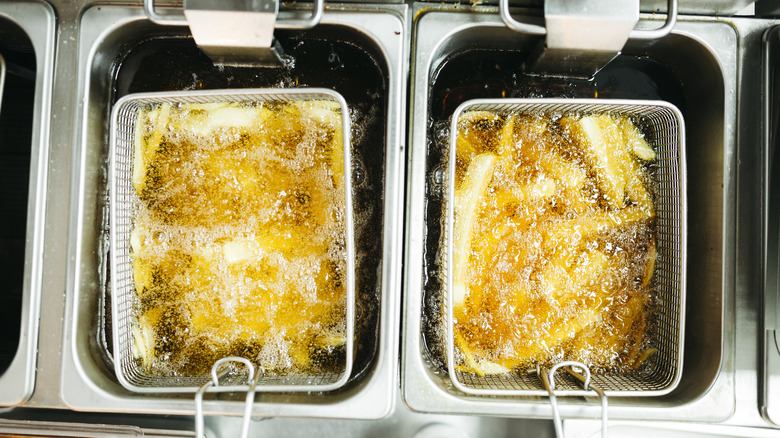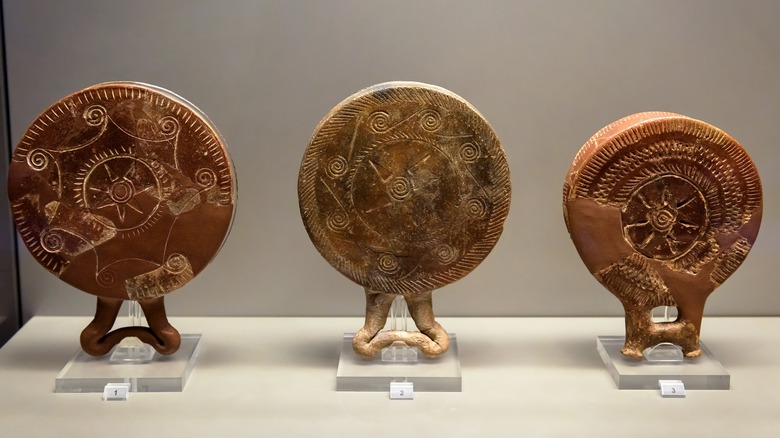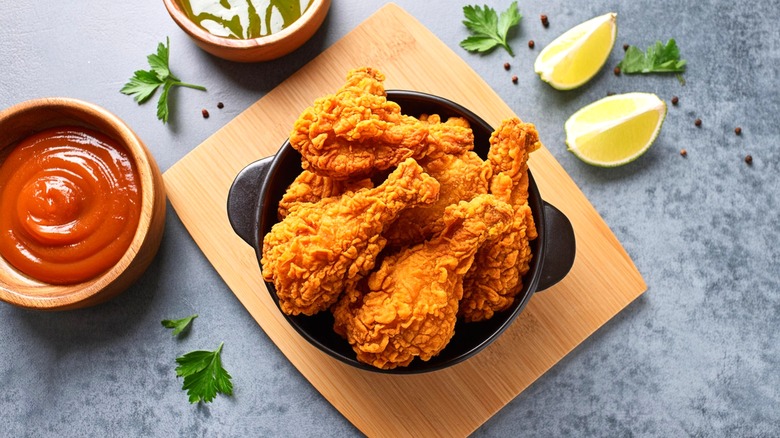The Origin Of Deep Fried Food Traces Back To Ancient Egypt
Tracing the history of deep fried food is a complex process. Like other food preparation methods, deep frying developed in many parts of the world at different times. Explorers and traders brought their cooking methods with them as they traveled from place to place. Some cultures created writing systems later than others, so historians and archaeologists rely on artifacts such as pots and tomb offerings to help tell the story of deep frying.
It is believed that ancient Egyptians deep fried food as early as 2500 B.C. The ancient Egyptian tomb of Vizier Rekhmire, which dates to approximately 1450 B.C., depicts people frying food. The food in question appears to be tiger nut cakes, which are triangular or cone-shaped and made of pounded tiger nuts (tubers from the yellow nutsedge, also called chufa), dates, honey, and water. The tomb scenes show workers sifting the ground meal, making the cakes, and frying them. Although we can't tell how deep the frying pot is, we know from the tomb inscriptions that fat of some kind was used during the cooking process.
Through trial and error, archaeobotanist Dr. Mennat-Allah El Dorry has re-created the recipe. She concludes that the cakes were probably cone-shaped, as a thicker, conical tiger nut cake does not fall apart as easily as a thin, triangular cake does.
[Featured image by Nina M. Davies via Wikimedia Commons | Metropolitan Museum of Art | Cropped and scaled | CC 1.0 Universal | Public Domain]
Other ancient peoples also enjoyed deep fried food
Fried foods were popular in other ancient cultures, too. Ancient Mesopotamian cooks used copper frying pans. Fourth-century frying pans have been found in Sudan. In ancient Greece's early Mycenaean period (1600-1400 B.C.), cooks also used frying pans.
The ancient Romans loved fried food. Apicus' "De Re Coquinaria," which might be the world's oldest cookbook, dating back to the first century A.D., includes a recipe for chicken and cream sauce in which the chicken is fried in Spanish [olive] oil and carefully lifted out of the oil, indicating that the chicken was probably deep fried. Ancient Roman potters even invented a type of non-stick pan, using a red-slip coating on the pan's inside surface to keep food from sticking.
During India's early Vedic period (1500 – 800 B.C.), cooks made apupa (today's malpua), or cakes made from barley flour, fried in ghee, and dipped in honey. The Rigveda, Hinduism's oldest sacred text, which was composed sometime around 1500 B.C., mentions these fried cakes. Food writer Puja Thomas-Patel, who has re-created this dish using information from the Rigveda, uses one to two cups of ghee to fry these barley cakes, which suggests that ancient apupa was probably a deep fried dessert.
Although Chinese cuisine focuses more on stir-frying than deep frying, the ancient Hanshi festival, or Cold Food festival, which dates back to at least the first century A.D., featured hanju, a cold, deep fried dough snack. This doughy treat, now called sanzi, is still made today.
Deep fried food from medieval times to the present day
As people began to explore distant continents, the tradition of deep frying food spread. In Japan, deep fried snacks called karinto became popular during the eighth century A.D. Portuguese explorers and missionaries brought the art of tempura, or breading and deep frying food, to Japan in the 16th century, hundreds of years after Japanese cooks started making karinto.
In Europe, deep frying was well-established by 1393, when "Le Menagier de Paris" was published. This advice guide for women includes a cuttlefish recipe that instructs the cook to fry the cephalopods in lots of oil. The author also distinguishes between frying in a pot and a pan, showing that deep frying was an accepted cooking method.
French fries have a surprising origin, according to some food historians. They believe the beloved deep fried snack originated not in France, but in Namur, Belgium, in the 1680s. After World War I, American soldiers returned home craving french fries, adding to their popularity. When the McDonald brothers opened their first drive-in restaurant in 1940, their menu included french fries.
Food writer Adrian Miller believes that fried chicken recipes arrived in the United States via Scottish settlers. Slaveholding Southerners gave fried chicken recipes to their enslaved African American cooks, who used their own cooking skills — handed down from African forebears — when preparing the chicken. Over time, fried chicken evolved to become the classic Southern dish that's beloved worldwide.


